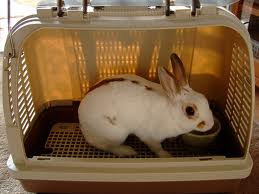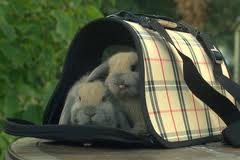Short distance traveling and finding a petsitter
Tips for a vacation when your bunny can’t come with you
Spring and summer are popular times for family vacations, and often we cannot take our pets with us when we travel. Making arrangements for your rabbit’s care while you are away is very important, and should not be left until the last minute! Thorough preparation will help ensure that your rabbit is properly cared for while you are away. Remember, rabbit sitting may be a whole new world for your pet-sitter.
Most rabbits prefer to stay in their own environment, so it is often best to have a pet-sitter come in and care for your bun while you are away. Your vet clinic may be able to recommend a local pet sitter. Or you can ask friends and fellow rabbit owners for recommendations, perhaps one of them would be willing to care for your rabbit while you are away.
If you have a rabbit with a chronic condition that needs to be monitored, or one who is on medication, you may need the rabbit
to have more supervision. If you cannot find a pet-sitter that you trust to properly care for your rabbit, you should consider
boarding instead. Most vet clinics will provide boarding facilities for pet rabbits. Boarding your rabbit requires much the same
preparation as using a pet-sitter, which we detail below.
Tips for stress-less travel:
- Provide your pet-sitter with information on each of your pets: name, markings/colour, age, pertinent health history, food preferences; the name, number and address of both your regular vet and an emergency vet. Don’t forget to leave cab fare for your sitter to take your bunny to the vet in case of illness, if necessary.
- Make financial arrangements with both your regular vet and an emergency vet in case your bunny needs medical care while you are away. Leave a blank cheque made out to a family member or friend, or a credit card impression with the vet to cover the costs of emergency medical care in the event that your vet will not defer payment until your return. It is also important for your pet sitter, vet and family member or friend understand what kind of financial commitment you have to your pet.
- Leave a phone number where you can be reached, and a secondary number where a family member or friend familiar with your bunnies can be reached in case you are unavailable. Call your pet-sitter while you are away. This allows you to make sure that your rabbits are being looked after properly, as well as gives you a chance to answer any questions your pet sitter may have.
- Provide detailed written instructions for feeding and care. Don’t take things for granted. What is obvious and routine to you and your bunny may not be obvious to someone else. It is better to provide too much detail than too little. Plus, if you have a professional pet-sitter, they will be seeing many animals in the course of her day, and may not remember every little detail about each of their clients.
- Introduce your pet-sitter to your pet before you leave. If you feel uncomfortable with how they interact with your rabbit, consider finding someone else. A change in routine is stressful enough for your bunny without having a pet-sitter who stresses him out even further.
- Educate your pet-sitter. As we all know, rabbits are not like cats and dogs, and health problems manifest themselves in subtle and different ways. If your pet-sitter is not familiar with rabbits, lend them a book on rabbit care, such as Rabbit Health 101, prior to your vacation. It is also helpful to leave articles on diet, health problems, etc.
- Explain the signs of illness. It is important for your pet-sitter to know that rabbits can quickly become very ill, and that they hide their symptoms well. If your rabbit behaves quietly he may be sick; insist that your pet-sitter bring your bunny to the vet if they are worried. Also impress upon them the importance of making sure that your rabbit has eaten his food, and that there are healthy droppings in the litter box.
- Show your pet sitter how to pick up and pet your rabbit. As silly as it sounds, some people do not know how to pet a rabbit. For example, rabbits do not like to be petted under their chin. It is best to ask your pet sitter not to pick up your rabbit unless the rabbit is ill, and needs to be picked up and put in a carrier to go to the vet. You do not want your rabbit to injure itself in an attempt to get away from your pet-sitter or because improper handling.
- Leave all supplies in one spot: on the kitchen table or right outside the door to the bunny room, for example.
- If you have extra litter boxes, pre-fill as many as you can. Describe how you clean the litter boxes, and what you use as litter material.
- Prepare your bunny’s salads ahead of time. Label them, and store them in zip lock bags. This will allow your pet sitter to have more time to spend with your pets. Plus, you will be sure that your rabbit is getting the right amount of food. If you will be away for longer than a week, leave money for veggies, or arrange for a friend or family member to go to the store. Don’t forget to provide a list of what to buy!
The time away from your rabbit is stressful enough for both you and your rabbit, but proper preparations can help to minimize this stress. If your rabbit gets really stressed by your absence, you might even want to leave a taped recording of your voice for your rabbit to enjoy while you are away.
Long distance traveling/moving and plane rides
Taking your rabbit on a road trip with you requires some preparation, but can actually be fairly stress-free for both you and your rabbit if planned carefully. Here are some helpful tips that will hopefully help to provide a safe and happy journey for your bunny:
If possible, pack plenty of food, hay and litter in case your rabbit’s brands are not readily available once you’re away from home. Produce selection varies by region so you may not be able to get your rabbit’s favourites. Take an assortment of fresh veggies – things that will entice your rabbit to start eating after you’ve arrived at your destination.You may also want to bottle some water and take it with you. Some rabbits will refuse to drink water that tastes differently than what they are used to.
While driving, it’s best to have your bunny caged for your safety as well as his. If possible, secure the carrier with a seatbelt by running it through the handle. Your rabbit’s carrier should be large enough so that he can stretch out comfortably, but not so
large that he will slide around. Starter rabbit cages make great travel cages for two bunnies.
Unless your carrier is quite large, you probably won’t have room for a litter box. Your bunny will use the cage as his litter box, so it is important to provide something absorbent on the floor of the cage. Artificial sheepskin is a good choice since it wicks the moisture away from the surface and is washable. Carry several pieces with you to change as necessary. Disposable absorbent bed pads (which are designed to hold many times their weight in liquid) are not a good idea because they may cause a blockage if ingested.
If traveling in the summer, cover the carrier with a white or light coloured towel so that it isn’t in direct sunlight. If your car is not air-conditioned you will need to provide your bunny with something cool to lie against. Freezer packs or frozen water bottles wrapped in towels work quite well.
Never leave your bunny unattended in a car in the summer. Even with the windows open on a mild day, the internal temperature of a car can become high enough to kill your bunny.
Many bunnies won’t eat or drink while the car is in motion, but you should provide food and water anyway. A small water bottle attached to the front of the cage works well, and should be spill-proof. There are also a variety of food bowls available that clip to the grill on the cage door. The bird section at a pet store will have some smaller sizes. Keep some hay in the cage in case your bunny wants to nibble. Romaine, kale or small chunks of carrot in the cage will sometimes entice them to eat even while the car is moving.
Stop every 2-3 hours and give your bunny a chance to relax and eat or drink. Provide your rabbit with plenty of wet leafy greens – if he’s not drinking much he will at least get some moisture this way. (Romaine lettuce is an especially good choice.)
Many hotels and motels accept pets.
Call in advance to find one that will allow your bunny to stay in your room.
The following link provides a list of hotels across Canada that accept pets: PetsWelcome.com
Keep the “Do Not Disturb” sign on the room door while you are away so that hotel staff do not enter your room and bother your rabbit.
Because your rabbit’s litter-box habits may not be perfect in a strange environment, it may be best to keep him in a room with tile or linoleum. Bring a rubber-backed mat, straw mat, or cotton mat to provide traction for him.
It is a good idea to carry a first-aid kit with some emergency supplies, such as feeding syringes and Oxbow’s Critical Care in case you have to syringe feed your rabbit. Although supplies such as simethicone, Pedialyte, baby food and canned pumpkin are generally readily available, it may be helpful to pack brands that you are familiar with. Having these supplies on hand may also save you from making a midnight trip to the pharmacy.
Preparation is the key to having a safe and pleasant car voyage with your bunny – and being equipped with whatever your bunny needs will certainly reduce your stress, too. Bon voyage!

